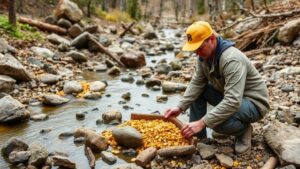How the Rich Placers of Bear Creek in the Black Range Were Exploited
How the Rich Placers of Bear Creek in the Black Range Were Exploited
The Bear Creek area in the Black Range, located in New Mexico, has a rich history marked by the discovery and exploitation of placer gold deposits. These deposits, which are composed of particles of gold that have been eroded from their original source and deposited in riverbeds, attracted a significant influx of prospectors during the 19th century. This article explores the methods of exploitation, the socio-economic impact on the region, and the long-term consequences of these mining activities.
The Geological Formation of Bear Creek
Located in the Sierra Mountains, the geology of Bear Creek is characterized by its unique rock formations and mineral deposits. area consists of metamorphic and sedimentary rock, which has facilitated the accumulation of placer gold. Through processes such as erosion and transportation by water, gold particles were deposited in gravel beds along the creek. This natural phenomenon created a highly lucrative opportunity for miners.
The Gold Rush Era: 1860s to 1880s
The Bear Creek area was first discovered in the early 1860s, sparking a mini gold rush that brought fortune seekers from across the United States. influx of miners and entrepreneurs transformed the landscape as they sought to exploit the rich placer deposits. Notable figures, such as the legendary prospector Thomas “Tom” Smith, played critical roles in this era, leading to further exploration and exploitation of the creek.
- The discovery of gold in 1866 marked the beginning of significant mining operations.
- By the late 1870s, reports indicated that thousands of miners had descended upon the area.
Methods of Placer Gold Mining
Miners employed a variety of techniques to extract gold from the placers of Bear Creek. Some of the most notable methods included:
- Panning: The simplest and oldest method, where miners used shallow pans to wash gold from dirt and gravel.
- Hydraulic Mining: A more destructive technique that used high-pressure water jets to dislodge rock and soil, washing it down for gold extraction.
- Drift Mining: This involved digging horizontal tunnels into the creek banks to access gold-rich deposits.
Economic Impact and Development
The exploitation of placer gold significantly impacted the regional economy. Services such as supply stores, saloons, and boarding houses flourished to support the burgeoning mining community. Plus, this led to increased transportation activities as railroads and roads were developed to facilitate the movement of goods and people.
But, rapid development also had adverse effects, including:
- Environmental degradation due to intense mining operations.
- Socio-political tensions as miners clashed over claims and land ownership.
Long-term Consequences of Mining
While the initial rush yielded substantial wealth, the long-term consequences of exploitation are still evident today. The mining practices employed often led to lasting environmental damage, such as:
- Deforestation and soil erosion resulting from the removal of vegetation.
- Water pollution from heavy metals and sediment runoff into Bear Creek.
Also, the rush eventually led to a decline as easily accessible gold deposits were exhausted, leaving behind a legacy of abandoned mining sites and economic recession in the area. transformation from a prosperous mining hub to a ghost town serves as a cautionary tale regarding natural resource exploitation.
Conclusion: Lessons Learned
The rich placers of Bear Creek in the Black Range represent both opportunity and consequence. While the pursuit of wealth during the 19th century spurred economic growth and development, it also reminds us of the importance of sustainable practices in resource management. Future generations can learn from this historical example to balance economic aspirations with environmental stewardship.
As we examine the history of Bear Creek, it becomes clear that exploitation without foresight can lead to significant challenges. Emphasizing responsible mining practices is crucial in preserving such rich geological areas for posterity.

